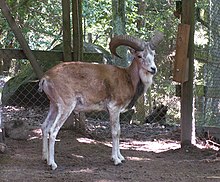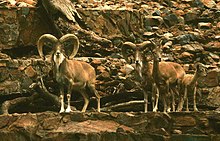| Urial | |
|---|---|

| |
| Bukhara urial (Ovis vignei bochariensis) at Nordens Ark, Sweden | |
| Conservation status | |
 Vulnerable (IUCN 3.1) | |
| CITES Appendix I (CITES) | |
| Scientific classification | |
| Domain: | Eukaryota |
| Kingdom: | Animalia |
| Phylum: | Chordata |
| Class: | Mammalia |
| Order: | Artiodactyla |
| Family: | Bovidae |
| Subfamily: | Caprinae |
| Tribe: | Caprini |
| Genus: | Ovis |
| Species: | O. vignei |
| Binomial name | |
| Ovis vignei (Blyth, 1841) | |

| |
| The range of Urial | |
| Synonyms | |
|
Ovis orientalis vignei | |
The urial (/ˈʊəriəl/ OOR-ee-əl; Ovis vignei), also known as arkars, shapo, or shapu, is a wild sheep native to Central and South Asia. It is listed as Vulnerable on the IUCN Red List.
Taxonomy
Ovis vignei was the scientific name proposed by Edward Blyth in 1841 for wild sheep in the Sulaiman Mountains. The specific name honours Godfrey Vigne (1801–1863).
The vignei subspecies group consists of six individual subspecies:
- Ladakh urial (Ovis vignei vignei): India (Ladakh), northern Pakistan, Kashmir
- Transcaspian urial (Ovis vignei arkal): Ustjurt-Plateau (Turkmenistan, Uzbekistan, northern Iran) and western Kazakhstan
- Blanford's urial or Baluchistan urial (Ovis vignei blanfordi): Pakistan (Balochistan)
- Bukhara urial (Ovis vignei bochariensis): Uzbekistan, Tajikistan, Turkmenistan, Afghanistan
- Afghan urial or Turkmenian sheep (Ovis vignei cycloceros): southern Turkmenistan, eastern Iran, Afghanistan, Pakistan (north Balochistan)
- Punjab urial (Ovis vignei punjabiensis): provincial animal of Punjab, Pakistan
Characteristics

Urial males have large horns, curling outwards from the top of the head turning in to end somewhere behind the head; females have shorter, compressed horns. The horns of the males are up to 100 cm (39 in) long. The shoulder height of an adult male urial is between 80 and 90 cm (31 and 35 in).
Distribution and habitat
The urial is native to montane areas in the Pamir Mountains, Hindu Kush and Himalayas up to an elevation of 4,500 m (14,800 ft). It is distributed from northeastern Iran, Afghanistan, Turkmenistan, Tajikistan, Uzbekistan and southwestern Kazakhstan to northern Pakistan and Ladakh in northwestern India. It prefers grassland, open woodland and gentle slopes, but also inhabits cold arid zones with little vegetation.
Behaviour and ecology
The mating season begins in September. Rams select four or five ewes, which give birth to a lamb after a gestation of five months.
References
- ^ Michel, S & Ghoddousi, A. (2021) . "Ovis vignei". IUCN Red List of Threatened Species. 2020: e.T54940655A195296049. doi:10.2305/IUCN.UK.2020-2.RLTS.T54940655A195296049.en. Retrieved 16 January 2022.
- ^ Blyth, E. (1841). "An Amended List of the Species of the Genus Ovis". The Annals and Magazine of Natural History; Zoology, Botany, and Geology. 7 (44): 248–261.
- Beolens, Bo; Watkins, Michael; Grayson, Michael (November 18, 2009). The Eponym Dictionary of Mammals. JHU Press. ISBN 9780801895333 – via Google Books.
- "Green Pioneers - Chapter 13". Archived from the original on 2008-07-03. Retrieved 2009-03-15.
- Kobilinsky, Dana (2023-07-26). "JWM: Connectivity could aid Pakistan's struggling wild sheep". The Wildlife Society. Retrieved 2023-07-31.
- Nowak R. M.: Walker's Mammals of the World, Sixth Edition. The Johns Hopkins University Press, Baltimore, London, 1999.
- Namgail, T., van Wieren, S.E., Mishra, C. & Prins, H.H.T. (2010). Multi-spatial co-distribution of the endangered Ladakh urial and blue sheep in the arid Trans-Himalayan Mountains. Journal of Arid Environments, 74:1162-1169.
- Lingen, H.: Großes Lexikon der Tiere. Lingen Verlag, Köln.
- Prater, S. H.: The Book of Indian Animals, Oxford University Press, 1971.
- Menon, V.: A Field Guide to Indian Mammals, Dorling Kindersley, India, 2003
- CITES Instruktion für den grenztierärztlichen Dienst
- Proposal about subspecies of Urial
- Yahya M. Musakhel et al. 2006: Identification of Biodiversity Hot Spots in Musakhel District balochistan Pakistan.
External links
| Taxon identifiers | |
|---|---|
| Ovis vignei | |